|

by Tom Van Flandern
from
MetaResearch Website
Contents
ABSTRACT
The so-called "Face" on Mars and the
surrounding anomalous objects in a region called "Cydonia" appear at
first glance to be randomly located and oriented on the planet. But
it has previously been established that the martian poles had a
different location with respect to the surface of the planet in the
past, and apparently jumped from that location to the present one in
relatively little geological time. We draw attention to the fact
that the Cydonia area is right on the old martian equator, and the
"Face" is oriented perpendicular to that old equator, to within the
measurement uncertainties.
This has only about a 1% probability of
occurring by chance. Both the line of inquiry that led to this
discovery and a possible purpose for building such an artificial
structure looking into space were suggested by the exploded planet
hypothesis. Taken in conjunction with the finding of bilateral
symmetry in the Face and the anomalous nature of other nearby
objects on Mars, the weight of existing evidence has, in this
author's opinion, shifted in favor of an artificial origin of the Cydonia complex.
With luck, the Mars Global Surveyor spacecraft now
en route to Mars will confirm or refute this conclusion.
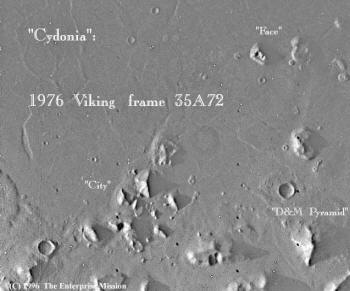
Figure 1.
Overview of Cydonia region on Mars. North is up. The frame
height is about 1.5 degrees or 80 km.
Back to Contents
Description of Cydonia
The Cydonia region of Mars (see Figure 1) is located at 41° north
latitude, 10° west longitude on the red planet. It was photographed
several times by NASA's Viking Mars-orbiting spacecraft in the
mid-to-late 1970s. One ground object drew the attention of
researchers because of its striking resemblance to a human face. In
the opinion of many who have viewed the higher resolution images,
the resemblance is closer than seems likely to have arisen by
chance, despite half the "face" being hidden in shadow. (See Figure
2.)
Because it is a three-dimensional "face" and not just a profile,
it has been described as the next best depiction of a human face in
stone on its (~ 1 kilometer) size scale in the explored solar system
after Mount Rushmore in South Dakota.
The immediately surrounding area likewise contains a number of
anomalous-looking objects. One of them, dubbed the "D&M pyramid"
after its discoverers Vincent DiPietro and Gregory Molenaar, is
shown in Figure 3. It has a more-than-passing resemblance to a
four-sided, or possibly a five-sided, pyramid. The formation of a
small crater seen very close to the base on the shadowed side has
apparently thrown debris onto that side of the object, and possibly
caused it to split or separate, leading to the ambiguity in the
number of original apparent pyramidal faces.
But the three faces not
coated with debris appear remarkably smooth and triangular,
separated by seemingly linear edges.
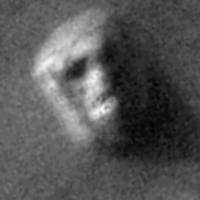
Figure 2.
Close-up of the "Face" at Cydonia on Mars.

Figure 3.
Close-up of "D&M pyramid" at Cydonia on Mars.

Figure 4.
Close-up of "Fortress" at Cydonia on Mars.
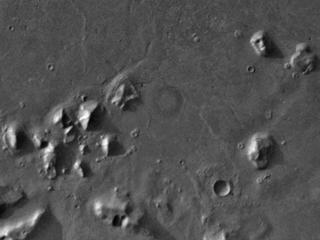
Figure 5.
Close-up of "City" showing its relation to the "Face" and
"Fortress".
Still another nearby object has been dubbed the "Fortress" because
of a modest resemblance to structures called that on Earth. (See
Figure 4.) Its linear features and sharp angles suggest
artificiality to some. A nearby cluster of vaguely pyramidal objects
surrounding some unusual small mounds not commonly seen away from
Cydonia has been dubbed the "City". (See Figure 5.)
Two or perhaps
three other nearby features are each in its own way mildly anomalous
or unique on the planet. These may be viewed in (Carlotto, 1991), in
(DiPietro, Molenaar & Brandenburg, 1988), or on
http//www.psrw.com/~markc/marshome.html.
Back to Contents
Summary of the Exploded Planet Hypothesis (eph)
In (Van Flandern, 1993), the author provided extensive evidence of
the explosion of a former major planet in the main asteroid belt.
Such evidence may be found all over the solar system. A few
highlight points include the following:
Asteroid orbits fill the available range of positions and velocities
between Mars and Jupiter that are stable against planetary
perturbations over millions of years. Their original population was
clearly far greater, with only a small percentage of the original
mass still present. Some asteroid orbits, most notably the Trojan
asteroids near Jupiter's orbit, are not stable for time spans as
long as a billion years, and cannot be original members of the solar
system (Marzari, Farinella, et al., 1997).
Asteroid orbits possess "explosion signatures" – patterns first
catalogued for orbits of fragments of artificial Earth satellites
that blew up in orbit around the Earth, that are indicative of a
common origin at one point in space at one instant of time (Gabbard,
1974).
Many meteorites show evidence of separation of heavy elements from
light elements by gravity (called "chemical differentiation"), as
would normally require a planetary-sized parent body.
All meteorites have relatively young cosmic ray exposure ages,
indicating they have not been traveling in space in their present
form since the solar system's origin billions of years ago. They
must be fragments of much larger bodies. But collisional
fragmentation is rare enough that most meteorites should show much
older exposure ages than they do. So some other large-scale
fragmentation process seems required.
The predicted statistical properties of the orbits of fragments
ejected to a great distance from an explosion in the main asteroid
belt are well fulfilled by "new" comets. Some of these properties
were unknown before being predicted by the explosion model and
confirmed in the actual orbits of new comets (Van Flandern, 1978).
Comet comas seem to have all the properties of the predicted debris
clouds that should accompany fragments from an explosion. One of
these is visibility of the coma all around the orbit. The standard
model tries to explain comas by outgassing from a single nucleus as
the comet approaches the Sun. But
Comet Hale-Bopp, for example, had
a fully developed coma when first photographed out near the orbit of
Uranus.
Comets and asteroids, to the surprise of mainstream astronomy,
appear to be indistinguishable as classes with respect to physical
and chemical properties such as reflectivity and spectra. No unique
identifying characteristic seems to exist, as if both had a common
origin. Yet in standard models, asteroids originated in the inner
solar system and comets in the outer regions, and the two should be
quite chemically and spectrally distinct.
The explosion model expected debris clouds around asteroids and
comets. This led to a well-publicized 1991 prediction that
satellites will be found around both types of bodies. Mainstream
astronomers were shocked when the Galileo spacecraft found a moon
orbiting asteroid Ida in 1993.
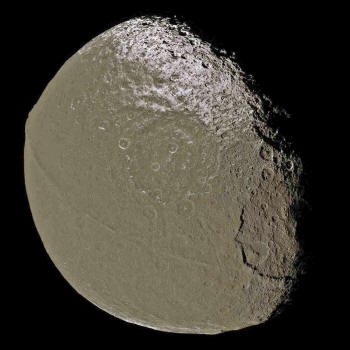

Figure 6.
Saturn's half-bright, half-dark moon Iapetus.
The explosion would have sent a blast wave of black, carbonaceous
material through the entire planetary system. In fact, airless
bodies are coated by just such black residue precisely to the extent
they could have been exposed to such a blast wave. The most striking
example is Saturn's moon Iapetus, which spins so slowly (once per 80
days) that only one side could have been coated by the blast. An
unsolved mystery of long standing about Iapetus is why it is
icy-bright on one side and coal black on the other. (See Figure 6.)
Over 100 lines of evidence bearing on the comparison of the exploded
planet hypothesis and the many standard models it would replace are
discussed in (Van Flandern, 1993).
The two strongest lines of
evidence are:
(1) the occurrence among comet orbits of every
statistical property of orbits expected to result from an explosion
origin, including some not previously known; and
(2) the a priori
prediction of the main physical characteristics of comets by the
explosion-debris-cloud ("satellite") model.
An example of the former
is the expectation of a population of "new" comets close to solar
system escape velocity falling back into the planetary region for
the first time since the explosion. An example of the latter is a
quantitative prediction of the mean relative speeds of split comet
fragments as a function of heliocentric distance -- a feat that is
by itself a virtual proof of the explosion-debris-cloud model for
comets.
The recent discovery of a second belt of fragments orbiting the Sun
in large numbers beyond the orbit of Neptune suggests that planetary
explosions into asteroid belts are not rare events on time scales of
billions of years. The mean orbital period of new comets tells us
that the most recent "planetary" explosion event happened 3.2
million years ago, and the angular momenta of new comets locates
that explosion somewhere within or near the main asteroid belt.
The
number of new comets, integrated over 3.2 million years, indicates a
total mass of the parent body somewhere between that of the largest
asteroid Ceres and that of our Moon. Consistent with that finding,
the most common type of meteorites found on Earth, the chondrites,
are from a parent body too small for chemical differentiation to
have occurred, as is generally true for moon-sized bodies.
Back to Contents
Chronology
|
Geological boundary |
Date |
CHRONOLOGY |
|
Permian-Triassic (P/T) |
336 Mya |
15-Earth-mass "Planet K" (taken from M.W. Ovenden’s proposed name "Krypton") exploded in the outer main asteroid belt, giving rise to C-type asteroids. Iron meteorites are the survivors remaining in Earth-crossing or
bits from this long-ago catastrophe that wiped out 90% of all species on Earth. Ceres and perhaps also Pallas, Juno, and/or Vesta may have been moons of this planet prior to the explosion. The large number of Earth-crossing asteroids generated by this explosion then continued to pepper Earth over the next 50-million-plus years, accounting for the seemingly long duration of this cataclysm. |
|
Cretaceous-Tertiary (K/T) |
65 Mya |
8-Earth-mass "Planet V" (the original fifth planet) exploded in the inner main asteroid belt, giving rise to S-type asteroids. Stony-iron and achondritic meteorites are the survivors remaining in Earth-crossing orbits today, of the event associated with the extinction of the dinosaurs and a single global fire. Mars and Body C were presumably moons of
Planet V before this explosion. Other lesser events at 38 Mya ("Body E") and perhaps 16 Mya ("Body D") may have been the explosions of other former moons. |
|
Pliocene-Pleistocene |
3.2 Mya |
0.01-Earth-mass Body C (source of today’s comets) exploded in the inner asteroid belt, giving rise to chondritic meteorites and much of the current population of small Earth-crossing asteroids. Body C and Mars were most probably former
moons of Planet V prior to the explosion of the latter. The two abandoned moons may then have remained gravitationally bound to one another as parent and moon until the explosion of Body C. |
|
Table 1.
(Mya = million years ago)
I call this most recent exploded object "Body C" to indicate its
association with comets and chondrite meteorites. Although this
astronomically recent event, which coincides with the
Pliocene-Pleistocene boundary in the geological record on Earth, was
apparently the source of all comets still existing today, comets
from such an explosion cannot survive beyond about 10,000,000 years
after the event because of galactic tides. Chemically differentiated
meteors and the larger asteroids presumably originated from earlier
explosions of larger planet-sized bodies.
Piecing together a tentative scenario from meteorite compositions
and exposure ages, and from geological evidence of mass-extinction
events of global extent, the chronology in Table 1 seems indicated
(Van Flandern, 1995).
This chronology is based on clusterings in meteorite cosmic ray
exposure ages (Caffee, Goswami, et al., 1988) and the dating of
tektite strewn fields on Earth (O’Keefe, 1975), plus the major
geological events shown in Table 2.
|
Event
|
Time of Event
(my – bp) |
Magnitude
(relative) |
Duration
(years) |
Certitude
|
|
Archeozoic/Proterozoic |
2,600 - 2,500 |
200 |
100,000,000? |
very high |
|
Mid-Proterozoic |
1,800 |
10 |
sudden |
high |
|
Proterozoic/Cambrian |
590 |
5 |
sudden |
very high |
|
Cambrian/Ordovician |
505 |
5 |
sudden |
low |
|
Late Ordovician |
450 |
10 |
1,000,000? - tailing off |
very high |
|
Mid-Devonian |
420 |
2 |
sudden |
low |
|
Late Permian |
336-286± |
60 |
50,000,000, many events |
very high |
|
Triassic/Jurassic |
213 |
20 |
sudden |
high |
|
Jurassic/Cretaceous |
144 |
20 |
1,000,000? - tailing off |
medium |
|
Cretaceous/Tertiary |
65 |
2 |
400,000 - increasing |
very high |
|
Late Eocene |
38 |
15 |
sudden |
very high |
|
Pliocene/Pleistocene |
3.2 |
2 |
sudden |
medium |
|
Late Pleistocene |
0.026 |
1 |
sudden |
low |
|
Pleistocene/Holocene |
0.0115 |
5 |
sudden |
very high |
|
Table 2.
Major geological events in Earth history.
Back to Contents
Connection of the EPH to Mars
Early on, it became clear that asteroid and meteorite physical,
chemical, and dynamical evidence indicated at least two explosion
events in the main asteroid belt. Yet the Titius-Bode law of
planetary spacing strongly indicated that the gap between Mars and
Jupiter was large enough for exactly one missing planet.
Unrelated astronomical evidence had given strong hints that the
small planet Pluto and its near-twin moon Charon were not original
planets, but instead were escaped moons of Neptune (Harrington & Van Flandern, 1979). Still other unrelated considerations were
consistent with the suggestion that Mercury was originally a moon of
Venus that escaped into its own solar orbit in the early solar
system because of tidal interactions (Van Flandern & Harrington,
1976).
These considerations would have left Mars as the only
original planet in its mass range, the only planet strongly
inconsistent with a steady progression of planetary masses with
distance to either side of Jupiter, and the only planet with a
relatively slow spin rate but no companion large enough to slow its
spin through tidal interactions. It therefore seemed reasonable to
suggest that Mars was not an original planet, but rather a moon of
Planet V before the explosion of the latter.
-
same distance from the Sun
-
slow spin, as for a moon
-
hemispheric crustal dichotomy
-
geologically rapid 90° pole shift
-
original atmosphere gone
-
abundant short-term water
-
excess 129Xe
|
|
Table 3.
Summary of evidence that Mars is a former moon of Planet V
Since that speculative suggestion, many additional lines of evidence
have served mainly to amplify its probability of being correct. (See
summary in Table 3.) If Mars was a moon of Planet V at the time of
the latter's explosion, Mars would have been severely affected by
its proximity to the blast. Because of its mass, Mars must have been
in a synchronous lock, keeping the same face toward Planet V just as
our Moon keeps the same face toward the Earth.
So this scenario
first predicts that one hemisphere of Mars would have been heavily
bombarded, and the other barely touched by the explosion. That is
indeed a good description of the actual situation for Mars, for
which an overview is shown in Figure 7. Except for two extensive
lava extrusions, the border between highlands and lowlands is
remarkably linear, and almost coincides with a great circle inclined
about 35° to the present equator.
This sharp hemispheric border is
certainly a puzzlement for the often-proposed explanation that the
old Martian northern hemisphere was blown away by some huge
mega-impact.

Figure 7.
Martian cratered highlands (white) and lowland plains (shaded).
Left: western hemisphere, 180° to 0°.
Right: eastern hemisphere,
360° to 180°.
From (Christiansen and Hamblin, 1995).
Moreover, evidence of water erosion on achondrite meteorites,
presumed here to have originated from Planet V, indicates that the
exploded planet contained abundant water as well, much of which
would have hit Mars. Surely, such a dramatic event would have left
plentiful evidence on the red planet. Let us compare to what is
actually seen today.
In (Maran, 1992), we learn that the northern hemisphere of Mars is
only sparsely cratered, compared to the heavily cratered southern
hemisphere. (McGill & Squyres, 1991) discuss the huge crustal
dichotomy between the northern and southern hemispheres of Mars. The
southern crust is so much thicker than the northern that the center
of mass of Mars is offset from its center of figure by 3.6 km.
Moreover, the thick southern crust drops abruptly to the level of
the northern lowlands, with the surface sloping down 4 or 5
kilometers in a span of just a few hundred kilometers near the
present equator. But there are no mountain rings nor catastrophic
impacts to mark the boundary between highlands and lowlands, so the
cause of what is presumed to have been the destruction of the
ancient northern crust is generally considered unknown (Abell,
Morrison & Wolff, 1991).
There are two very large, relatively well preserved impact basins on
the bombarded southern plains:
-
the 2000-km diameter Hellas Basin at
43°S, 291°W
-
the 1200-km diameter Argyre basin at 50°S, 42°W
Numerous other large craters stand almost shoulder to shoulder in
the south. And unlike lunar craters, southern Martian craters have ejecta saturated with water, giving them a mud-like consistency that
caused them to flow along the ground after ejection from the crater.
Branching valleys with tributaries cover all the exposed high
terrain except at high latitudes, where they may have been eroded
away. Lava flows between large craters on the highlands show that
volcanism was occurring simultaneously with the formation of the
cratered terrain.
A noteworthy peculiarity is that many large
channels start close to the volcanoes in Elysium and extend several
hundred kilometers to the northwest, down the regional slope. And
several enormous channels emerge from the chaotic terrain east of
the Tharsis bulge canyons and extend northward. Finally, the Tharsis
bulge itself takes the form of high-elevation terrain and several
huge volcanoes in the Tharsis region at tropical latitudes on Mars.
This picture is indeed very much as the exploded planet hypothesis (eph)
with Mars as a nearby moon would expect. The actual data for Mars
are so close to expectations that one even sees evidence that many
of the impacts on the southern hemisphere near the equator were
northward-directed grazing impacts. (Strom, Croft & Barlow, 1992)
indicate that the cratering on Mars is more diverse than on any
other planet or satellite in the solar system.
(Chapman & Jones,
1977) tell us that:
-
the southern highland craters generally have low
rims and shallow depths (as if considerable in-filling occurred)
-
the craters smaller than 30 km are too few in number (as if erased
by near-simultaneous larger impact events)
-
the "erosion"
episode apparently consisted of a "pulse" contemporary with the
valley network formation
We might well ask where this "pulse" came
from if not a nearby planet that exploded.
If the parent planet were a few Earth masses in size, and Mars
subtended a few square degrees in its sky, then Mars would intercept
about 10-4 of the parent planet’s mass. Spread over one hemisphere
on Mars, this would imply a crustal build-up of about 20 km. This
agrees well with the actual crustal thickness of the southern
hemisphere, estimated to be 21 km (McGill & Dimitriou, 1990).
The
new material would have lower average mean density than the mantle
of Mars because it would be more loosely packed. This build-up would
shift the center of figure of Mars south about 10 km (half the
maximum build-up). But the center of mass would shift south by a
lesser amount because the material was less dense. The observed
3.6-km difference (Anderson, Jurgens, et al., 1996) is a reasonable
value in this scenario.
The only significant departure from intuitive expectations is that
the affected hemisphere is the southern one. In the normal course of
events, one would expect Mars to be struck on an east or west
hemisphere - the side permanently facing Planet V. Assuming that
happens, then after the explosion Mars would be rotating around an
axis that had more mass on one side than on the other because of the
one-sided bombardment.
This is an unstable configuration. With
Planet V gone, Mars would be forced to gradually re-orient its
entire body until it spun again about an axis with equal mass
balanced on all sides. This would involve an approximately 90° pole
shift until the spin axis passed through the middle of the
extra-heavy southern hemisphere. The actual pole position before the
Planet V explosion is only poorly known.
But from data in (Schultz &
Lutz, 1988, see p. 124), the oldest known pole position – near
Utopia Planitia (UP) – is roughly 90° away from the position near
Arcadia Planitia (AP) last occupied by the pole before it jumped to
its present location.
(Speculative intermediate pole positions
between UP and AP may be associated with re-orientation delays
caused by the co-orbiting of Mars and Body C.)
Not only is the prediction by the eph of a geologically rapid pole
shift in agreement with the data, but the approximately 90°
magnitude of that shift agrees as well. And the early pole shift(s)
are known to be geologically associated with the time the volcanic
eruptions began on Mars. This too fits the Planet V scenario because
when the north pole was still at location UP, the south pole 180°
away was near the Tharsis volcanoes.
Therefore, the UP-Tharsis axis
of Mars was the shortest axis. Following the 90° pole shift to AP,
the Tharsis volcano region was relocated to near the Martian
equator. Centrifugal force would try to flatten the new polar axis
and cause the new equator to bulge out. The region under the most
stress would have been the Tharsis region because it would have to
make the greatest adjustment - from shortest axis to the new
equatorial radius.
So this is where the extrusions from the martian
interior would erupt as the interior of Mars adjusted to the huge
new weight of its bombarded southern hemisphere. The present
Tharsis bulge, on which may be found the four largest shield
volcanoes in the solar system near its central region, was very
likely created at just this time.
Yet another consequence of proximity to a planetary explosion would
be to blow away a substantial part of the original atmosphere of
Mars. Again, there is evidence that Mars could have supported, and
probably actually possessed, a thicker atmosphere in the past (Lammer,
1996). This old atmosphere might have had a surface pressure up to
10 bars, a factor of 1000 greater than for the present martian
atmosphere, and ten times thicker than Earth's atmosphere.
Moreover,
contamination of the Mars atmosphere by gases from exploded Planet V
may then readily explain the general similarities between the
contents of gas bubbles in meteorite EETA79001 (presumed here to be
a piece of Planet V) and Viking spacecraft samples of the present
Mars atmosphere. Despite the often quoted statement that the match
was "almost exact", it is in fact not especially good. However, no
presently existing planet matched as well as Mars, perhaps
explaining why the quality of the match seems to have been
exaggerated (Van Flandern, 1996).
As further evidence of this scenario, we note that Mars has an
anomalous 129Xe content in its atmosphere that is nearly triple that
found on other bodies where it has been measured (DiPietro, 1996).
Since 129Xe is a second order nuclear fission by-product and does
not arise through normal nucleosynthesis, it has long been assumed
that an ancient supernova was responsible for the presence of that
isotope in the solar system. Then why does Mars have an anomalously
high amount of it? Again, its proximity to the eph event is an
obvious explanation for Mars in particular to be anomalous.
A missing step in the chronology is an identification of Body C.
From meteorite evidence, it must have been an undifferentiated body,
and therefore probably a small planetary moon rather than a planet
or an asteroid. This agrees with mass estimates based on counting
comets (Van Flandern, 1995).
Yet comets also indicate that it had a
high water content, perhaps even oceans, rather like those presently
conjectured to exist under the ice on Jupiter's moon Europa. A
factor in destabilizing the body for later explosion may have been
proximity to Planet V when the latter exploded, since Body C would
then have received an asymmetric bombardment similar to Mars.
If it
was another moon of Planet V along with Mars, it is interesting to
contemplate the logical sequence of events following Planet V's
explosion. Mars and C are released from their satellite orbits into
a solar orbit. With typical satellite velocities, an eccentricity of
order 10% seems likely to result for the solar orbit; and Mars does
have just such an eccentricity, presently 9%.
Once Planet V has dissipated, Mars and C may well find themselves
within their mutual gravitational sphere of influence. Much like
Pluto and Charon following their probable escape from
Neptune, Mars
and C might therefore remain gravitationally bound to one another.
The two would remain a stable binary system, evolving their rotation
rates and orbits under the influence of tidal friction, until the
explosion of Body C 3.2 Mya.
That smaller explosion would pepper
half of Mars with smaller, fresher craters and an enormous amount of
water. A new round of volcanism would be set off as the weight of
the newly bombarded hemisphere increased. This could account for the
evidence of flowing water on mainly the south hemisphere, with some
overlap to the north, at around the same time as the cratering and
volcanism. Following the explosion of Body C, Mars would then
undergo the its final pole re-orientation to its present spin axis
as the red planet began to orbit the Sun alone.
Finally, the high deuterium to hydrogen (D/H) ratio of the martian
atmosphere implies that almost all its formerly abundant flowing
water has been lost in just the last 105 to 107 years. That, in
turn, is consistent with the chronology of the eph, for which this
main water dump happened at 3.2 Mya. According to this scenario, the
water dumped on Mars then was far greater in volume, and evaporated
in far shorter a time, than has seemed possible with all previous
scenarios considered up to now.
Back to Contents
Connection of the EPH and Pole Shift to Cydonia
Either the unusual landforms at Cydonia on Mars are natural
features, or they are artificial constructs of intelligent beings. A
number of tests of artificiality have been proposed since the area
was discovered. For example, it has been noted that the "Face" is a
three-dimensional face, not merely a profile or an outline. As such,
it still looks like a face from every angle.
Moreover, the U.S. military has perfected the use of fractal
techniques to search for man-made objects camouflaged by terrain in
aerial photographs. It has been well demonstrated that natural
objects show a high degree of fractal content, whereas artificial
objects have more symmetry and regularity. This software was applied
to various features on Mars, with the finding that the "Face" gave
by far the highest degree of artificiality of any image tested,
usually high enough to assure artificiality of the object if it had
appeared on Earth.
In the immediate vicinity of the Cydonian landforms, but in general
not elsewhere on the martian surface, can be found more than a dozen
small, raised mounds of similar she distribution of the mounds
(Crater & McDaniel, 1997; see also
http//www.mcdanielreport.com/)
shows that the random geology hypothesis fails to account for the
regularity and redundancy of geometric patterns in these formations.
At the least, enigmatic geology is involved, the alternative being
intelligent design.
Each of these features, taken in conjunction with the presence of
several other anomalous objects in close proximity, have induced a
number of serious scientists to seek to develop further tests of
artificiality, in consideration of the importance of such a finding.
I have proposed four such tests myself, although it now appears that
others have made some of the same proposals before me.
These were:
-
Bilateral symmetry of the Face:
If natural, the chances are
negligible that the shadowed side of the object would resemble a
symmetric half of a human face, and ought to be a random pile of
rocks or sand. If artificial, the mirror image of the visible half
face is to be expected.
-
Culturally significant location:
A culturally meaningful location of
the structures, such as on the equator or in the lowest valley on
the planet, would suggest artificial design; whereas a seemingly
random location would suggest a natural formation.
-
Orientation:
A human face has a natural "up" and "down". A
polar-aligned north-south orientation of a face structure suggests
artificiality, while any other orientation suggests a natural
formation.
-
Functionality:
The faces on Mount Rushmore in South Dakota are
visible to people on the ground. The "Face" on Mars stares up into
space, yet cannot be seen from any other planet, even with our
largest telescopes. A lack of obvious purpose suggests a natural
object, although we cannot hope to guess all possible purposes of
its hypothetical builders. An obvious purposefulness would suggest
artificiality.
|
Test |
PASS |
FAIL
|
|---|
|
"Face" in 3-D |
* |
| |
fractal test |
* |
| |
mounds non-random |
* |
| |
nearby context |
* |
| |
bilateral symmetry |
|
?
| |
location |
|
X
| |
orientation |
|
X
| |
purpose |
|
X
|
|
Table 4.
Original status of tests of artificiality of Cydonia
landforms.
When I proposed these tests, it appeared that the first (and
strongest) test would not be performed until another spacecraft
returned to take higher resolution pictures; but that the three
weaker tests seemed to favor a natural formation. The status of the
eight tests of artificiality then known was as shown in Table 4.
However, recent advances in image processing software (first applied
to the Cydonia structures by Mark Carlotto) allowed another
high-resolution image of the Face taken at a slightly higher Sun
angle to be enhanced enough to bring out some detail on the shadowed
side. The result is shown in Figure 8. While the symmetry is far
from perfect, owing in part to an impact crater in the "headdress",
it is certainly more suggestive of symmetry than of randomness.
Similar results have been obtained using other enhancement
techniques by (DiPietro, Molenaar & Brandenburg, 1988), and even by
skeptics of artificiality such as M. Malin at
http://barsoom.msss.com/education/facepage/face.html.
S.V. McDaniel notes the symmetrical headpiece, the second
eye-socket, and the continuation of the mouth and "teeth" to the
other side of the face as the most significant points of symmetry.
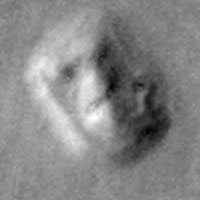
Figure 8.
The "Face" at a higher Sun angle,
image processed to bring out
detail on the shadowed side.
Now a development has shed further light
on this important artificiality question. Following a discussion of
the exploded planet hypothesis by the author on the nationally
syndicated Art Bell radio talk show on December 20, 1996, an
listener who wishes to remain anonymous sent email via the
Meta Research web site. Assuming the landforms at
Cydonia on
Mars had been built by advanced beings, the listener suggested that
perhaps the exploded planet might have been the cause of the demise
of their civilization.
If that were the case, then the structures at Cydonia would have necessarily been built before the most recent
explosion event. Having heard me mention the martian pole shift as
probably caused by the explosion, the listener asked where the
"Face" on Mars was relative to the prior location of the martian
pole.
This seemed an interesting and logical question. According to
(Schultz, 1985), the most recent stable position of the martian
north pole before its present one (designated AP in our earlier
discussion) was at 45°N, 160°W. On that assumption, I computed the
great circle arc between that former pole position and the
coordinates of the "Face" at Cydonia, 40.89°N, 9.52°W.
If s is that
arc length, the formula is:
cos s = sin 45 sin 40.89 + cos 45 cos 40.89 cos(160 - 9.52)
from which we compute s = 90.1°. The old pole position was specified
to the nearest 5°, and conversations with the author of that study
suggest it is probably good to the nearest 10°. This implies an
estimated mean error of +/- 5 great circle degrees. This would
likewise be the mean error for s.
So a result that is just 0.1° from
the old equator is necessarily somewhat fortuitous. Nonetheless, it
is clear that Cydonia formerly occupied a location quite close the
previous martian equator. And this passes the "location" test of
artificiality in our Table 4 since the equator is culturally
significant and there is no known reason why a natural landform
would prefer the equator to any other surface location.
Given that
there are 41253 square degrees on any sphere, the statistical
probability of a random point lying within 5° of the equator of the
sphere is 9%. Therefore, the probability that this result for Cydonia is culturally significant rather than chance is about 91%.
With the location test nominally passed, the orientation test took
on extra importance. The present orientation of the "Face" is 31°
west of north. If a is the orientation correction between present
pole and former pole viewed from Cydonia, the formula for it is:
sin a = -cos 45 sin (160 - 9.52) / sin s
...from which we compute a = -20.4°. This brings the "Face" three times
closer to the culturally significant north-south orientation than it
now is. An overview of the situation may be seen in Figure 1, where
the straight gray line parallels the old martian equator.
However, we have landforms other than the "Face" to aid in this
orientation test. The primary linear features in other nearby
landforms also show a preference for nearly the same orientation as
the "Face". We see these in Figure 9 courtesy of Mark J. Carlotto,
who also provided the following descriptions:
The "rounded
formation", the pyramid in the City, the Fortress, and the Face,
though different in shape, are similar in both size and orientation.
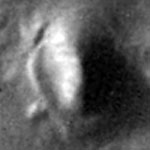 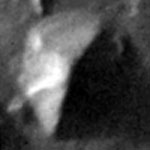 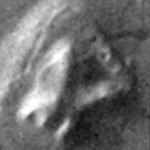 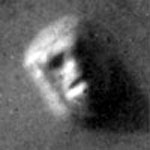
Figure 9.
The orientation of a primary linear feature in four landforms at
Cydonia is essentially the same,
each perpendicular to the old
equator.
The present-day west-of-north orientations of the best defined edge
on each of these objects are as follows: left edge of "rounded
formation" in City, 30.8°; left edge of pyramid in City, 30.8°;
right edge of Fortress, 34.5°; left edge of Face, 30.9°. The average
value for the four objects is 31.8° +/ -1.6°.
Therefore, when we apply the correction a to refer these objects to
the estimated location of the previous martian pole, their average
orientation is 11.4° +/- 5.2° west of due north. Since any value
between 0° and 90° is equally probable for a natural formation, the
probability of this being culturally significant rather than chance
is 87%. Of course, the probability of three of these four objects
having the same orientation to within 0.1° is very much smaller.
But
considering that probability would introduce a possible selection
bias into our statistics, which we very much wish to avoid. Without
that help, the net probability of both the location and the
orientation tests being passed by chance to the degree shown here is
just 1%. The probability of bilateral symmetry to the degree seen is
also too subjective to quantify, but is surely small.
Although these findings are independent of the exploded planet
hypothesis, the eph led us to this line of thought. And it has
further implications. Under eph premises, Mars is a former moon of
Planet V. And as we have seen, Mars would have kept the same side
permanently toward Planet V.
So our line of reasoning has suggested
a previously unimagined cultural purpose for a "Face" to be built
looking up into space: It would have been visible to the presumed
occupants of parent Planet V. We can readily imagine that the
hypothetical builders would have outfitted the "Face" and landforms
with appropriate illumination to make them visible even when in
total darkness.
Hence, a cultural purpose for a "Face" looking up
into space has arisen from our considerations, thereby completing
the fourth test, as shown in Table 5.
|
Test |
PASS |
FAIL
|
|---|
|
"Face" in 3-D |
* |
| |
fractal test |
* |
| |
mounds non-random |
* |
| |
nearby context |
* |
| |
bilateral symmetry |
* |
| |
location |
* |
| |
orientation |
* |
| |
purpose |
* |
|
|
Table 5.
Present status of tests of artificiality of Cydonia
landforms.
However, the unraveling of this intriguing cosmic puzzle is not so
simple as the naive picture just painted, and we have some loose ends
to tidy up. If the Cydonia landforms permanently faced Planet V at
the time of its explosion, they would now be buried under 21 km of
debris in the martian southern hemisphere. Moreover, the immediately
former martian pole location AP is apparently located within 10° of
the center of the original hemispheric dichotomy, as inspection of
Figure 7 can confirm.
This means AP was the martian pole after the
Planet V explosion. Since the Cydonia landforms were seemingly built
on the martian equator when AP was the pole, then the landforms
necessarily were built after the Planet V explosion. The location
that is now Cydonia was oriented about 100° away from the point on
Mars closest to the Planet V explosion.
In the scenario described earlier, Body C was also orbiting
Planet V
at the time of the explosion, and perhaps became gravitationally
bound to Mars following the explosion. It therefore seems plausible,
given that the Cydonia landforms are artificial, that the Cydonia
builders’ home planet was Body C, accounting for the absence of
overt evidence for an advanced civilization on the surface of Mars.
Body C would have suffered a fate similar to Mars when Planet V
exploded. However, the side facing away from Planet V would have
been spared the main force of the explosion, and suffered less
direct impact than even distant Earth. So we can picture that part
of the builders’ civilization was spared by taking refuge on the far
side of Body C, or perhaps by escaping to that moon from Planet V
before the latter’s demise.
The supposed civilization would have either evolved, or (if
pre-existing) have done its best to survive and recover, following
the Planet V explosion at 65 Mya. Body C would tidally evolve to an
orbit and spin rate synchronous with Mars. Mars, presumed to be the
more massive of the two, might or might not have become spin-locked
with Body C. At some point, the Cydonia landforms were built on Mars
for visibility from Body C.
Then Body C exploded at 3.2 Mya, leaving
only Mars, and triggering the final pole shift. This much smaller
explosion largely overlapped the earlier Planet V explosion on Mars,
but included more of the present western hemisphere and preventing
the sharp hemispheric boundary created by the earlier explosion from
being visible all around the planet. Cydonia again seems to have
been spared the brunt of the second explosion; so either Mars was
not spin-locked with Body C, or a precursor explosion broke the spin
lock shortly before the final destruction of Body C.
It is intriguing to note that this hypothesized civilization
apparently had the ability to save some of its members from the
deadly effects of one or both explosions by space transporting them
to the far side of nearby moons. But following the destruction of
their primary world, Body C, at 3.2 Mya, this species would have
been forced to choose between attempting to survive on
explosion-torn, atmosphere-stripped Mars, or long-distance
relocation to the most habitable of the remaining planets, Earth.
This is intriguing because the first appearance of hominids on Earth
also dates to just about the time of this last explosion, 3.2 Mya.
And it has been noted that the "Face" is apparently more
hominid-like than alien.
Back to Contents
Conclusions
The "Face" on Mars has now passed each test of artificiality yet
proposed. These tests include a three dimensional structure, a lack
of fractal patterns in the image, non-random distribution of the
nearby small mounds, proximity of other anomalous landforms, an
apparent bilateral symmetry, being located on the martian equator,
having a culturally significant orientation, and serving an apparent
culturally significant purpose.
It would be an exaggeration to say
that the case for artificiality is now compelling, and many
thoughtful people will still find that conclusion less likely than
all these "coincidences" put together. Yet the balance of the
evidence, considered objectively, now weighs clearly in favor of
artificiality over a natural origin of the Cydonian landforms.
As a counterpoint, it is sometimes argued that the probability of
artificial structures on Mars must be vanishingly small. However,
for all we know,
intelligent life may have developed elsewhere in
our galaxy long ago, and long since explored the galaxy and left
structures on all terrestrial planets in the galaxy. If that were
the case, then the probability of finding artificial landforms on
Mars is close to 100%.
This illustrates that the probability of the
Cydonia landforms being artificial is unknown, which is very
different from being very small. An unknown probability can lead to
either outcome without being statistically improbable.
It would be disingenuous to provide evidence for such a startling
conclusion if no verification was possible in the foreseeable
future. The author therefore hastens to point out that the Mars
Global Surveyor spacecraft is now en route to the red planet for a
mapping mission, with cameras able to take high resolution pictures
of such potential quality that the truth status of the artificiality
hypothesis could be made considerably clearer to all sometime during
1998.
It would be illogical to conclude that
the exploded planet
hypothesis was either verified or falsified by the outcome of the
Cydonia artificiality hypothesis. But both hypotheses have important
implications for one another, and go a long way toward providing
some understanding of the surprising and curious properties of Mars
that we have come to discover in this early space age.
However, in view of the preceding considerations, all might be wise
to prepare for the possibility of a cultural shock probably
unrivaled by any other in our generation.
Back to Contents
Acknowledgments
-
All the figures in this paper except Figure 7 are taken from NASA
photos.
-
Vincent DiPietro and Gregory Molenaar were the first
investigators to conduct scientific research on the Cydonian
anomalies, later joined by John Brandenburg (DiPietro, Molenaar &
Brandenburg, 1988).
-
The Cydonian anomalies have been widely
popularized by
Richard Hoagland (Hoagland, 1992).
-
NASA's role in
discouraging further investigation has been critiqued by Stanley
McDaniel (McDaniel, 1993).
-
The singularly important image
enhancements were the work of Mark Carlotto (Carlotto, 1991).
The author gratefully acknowledges invaluable discussions and
insights with members of the Society for Planetary SETI Research (SPSR),
and in particular contributions from John Brandenburg, Mark J.
Carlotto, Horace Crater, Vince DiPietro, Lambert Dolphin, Dan Drasin,
Jim Erjevac, Marie-Louise Kagan, Stan McDaniel, Brian O'Leary,
Ananda Sirisena, Jim Strange, Erol Torun, Dr. David Webb, and
Michael E. Zimmerman. Discussions with Michael Van Flandern were
also of great help in piecing together the various parts of this
intriguing puzzle.
Back to Contents
References
-
Abell, G.O., Morrison, D., and Wolff, S.C., Exploration of the
Universe, Saunders College Publishing, Philadelphia, 239-240 (1991).
-
Anderson, J.D., Jurgens, R.F., et al., "Shape and orientation of
Mercury from radar ranging data", Icarus 124, 690-697 (1996).
-
Caffee, M.W., Goswami, J.N., et al., "Irradiation records in
meteorites", in Meteorites and the Early Solar System, J.F. Kerridge
and M.S. Matthews, eds., Univ. of Arizona Press, Tucson, 205-245
(1988).
-
Carlotto, M.J., The Martian Enigmas, North Atlantic Books, Berkeley
(1991).
-
Chapman, C.R. and Jones, K.L., "Cratering and obliteration history
of Mars", Ann.Rev.Earth Planet.Sci. 5, 515-540 (1977).
-
Christiansen, E.H. and Hamblin, W.K., Exploring the Planets, 2nd
ed., Prentice Hall, Englewood Cliffs, NJ, p. 144 (1995).
-
Crater, H.W. and McDaniel, S.V., "Mound configurations on the
martian Cydonia plain: a geometric and probabilistic analysis",
revised and combined version of papers delivered to the Society for
Scientific Exploration meetings, 1995-96; submitted to J.Sci.Explor
(1997).
-
DiPietro, V., "Report of findings of life on Mars", copyright by
author, updated 12/15/96, p. 4 (1996).
-
DiPietro, V., Molenaar, G., and Brandenburg, J., Unusual Mars
Surface Features, Mars Research, Glenn Dale, MD, 4th ed. (1988).
-
Harrington, R.S. and Van Flandern, T., "The satellites of Neptune
and the origin of Pluto", Icarus 39, 131-136 (1979).
-
Hoagland, R.C., The Monuments of Mars, North Atlantic Books,
Berkeley (1992).
-
Gabbard, J.R., "Orbits of fragments from exploded satellites",
Tech.Mem. 74-3, Headquarters NORAD/CONAD/ADC, Colorado Springs, CO
(1974).
-
Lammer, H., "Atmospheric mass loss on Mars and the consequences for
the Cydonian hypothesis and early martian-life forms",
J.Sci.Exploration 10, 355-361 (1996).
-
Maran, S.P., ed., The Astronomy and Astrophysics Encyclopedia, Van
Nostrand Reinhold, New York, 412-414 (1992).
-
Marzari, F., Farinella, P., et al., "Collisional evolution of Trojan
asteroids", Icarus 125, 39-49 (1997).
-
McDaniel, S.V., The McDaniel Report, North Atlantic Books, Berkeley
(1992).
-
McGill, G.E. and Dimitriou, A.M., "Origin of the martian global
dichotomy by crustal thinning in the late Noachian or early
Hesperian", J.Geophys.Res. 95, 12595-12605 (1990).
-
McGill, G.E. and Squyres, S.W., "Origin of the martian crustal
dichotomy: evaluating hypotheses", Icarus 93, 386-393 (1991).
-
O’Keefe, J.A., Tektites and Their Origin", Elsevier Scientific Publ.,
150-151 (1976).
-
Schultz, P.H., "Polar wandering on Mars", Sci.Amer. 253, Dec. 94-102
(1985).
-
Schultz, P.H. and Lutz, A.B., "Polar wandering on Mars", Icarus 73,
91-141 (1988).
-
Strom, R.G., Croft, S.K., and Barlow, N.G., "The martian impact
cratering record", in Mars, H.H. Kieffer, B.M. Jakosky et al., eds.,
U. of Arizona Press, Tucson, 383-423 (1992).
-
Van Flandern, T., "A former asteroidal planet as the origin of
comets", Icarus 36, 51-74 (1978).
-
Van Flandern, T., Dark Matter, Missing Planets and New Comets, North
Atlantic Books, Berkeley, 155-236 (1993).
-
Van Flandern, T., "A revision of the exploded planet hypothesis",
Meta Research Bull. 4, 33-42 (1995).
-
Van Flandern, T., "Are the ‘Mars meteorites’ really from Mars?",
Meta Research Bulletin 5, 33-38 (1996)
-
Van Flandern, T. and Harrington, R.S., "A dynamical investigation of
the conjecture that Mercury is an escaped satellite of Venus",
Icarus 28, 435-440 (1976).
Back to Contents
|













